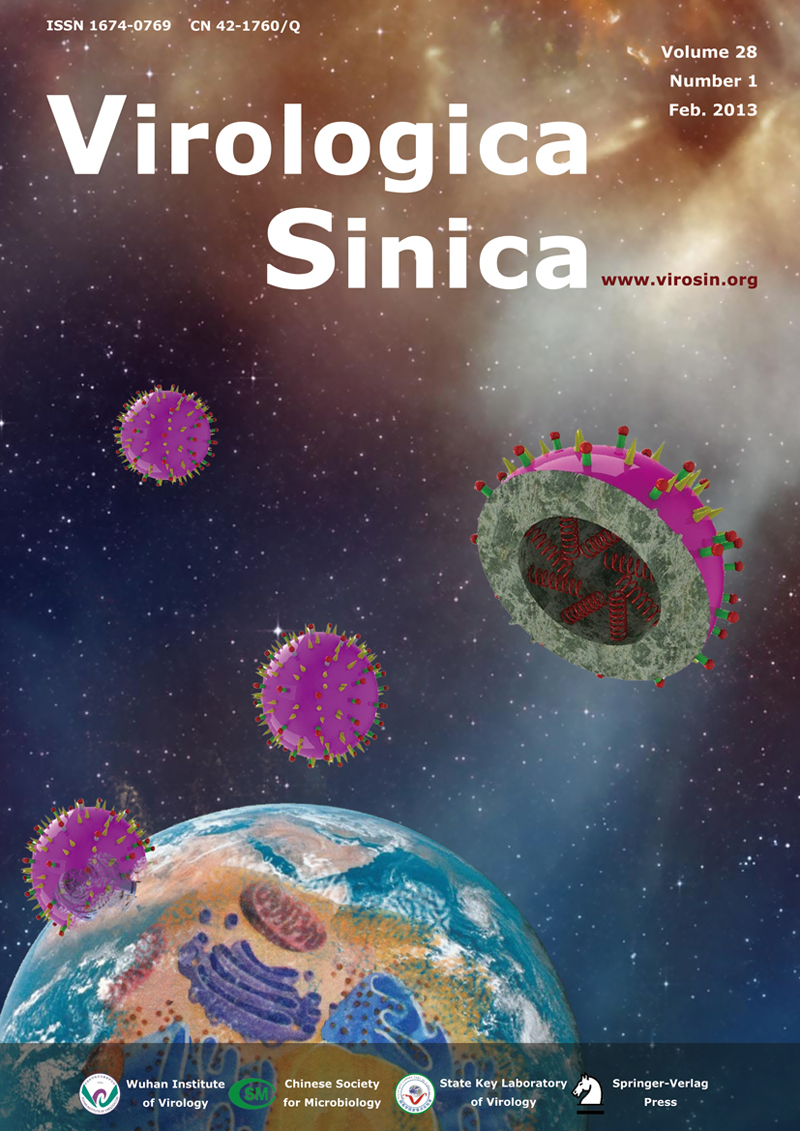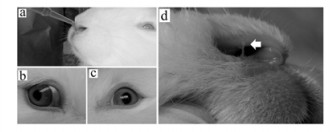-
Bahnemann H G. 1990. Inactivation of viral antigens for vaccine preparation with particular reference to the application of binary ethylenimine. Vaccine, 8: 299-303.
doi: 10.1016/0264-410X(90)90083-X
-
Caron L, Flores E F, Weiblen R, Scherer C F, Irigoyen L F, Roehe P M, Odeon A and Sur J H. 2002. Latent infection by bovine herpesvirus type-5 in experimentally infected rabbits: virus reactivation, shedding and recrudescence of neurological disease. Vet Microbiol, 84: 285-295.
doi: 10.1016/S0378-1135(01)00441-2
-
Chung H, Kim T W, Kwon M, Kwon I C and Jeong S Y. 2001. Oil components modulate physical characteristics and function of the natural oil emulsions as drug or gene delivery system. J Control Release, 71: 339-350.
doi: 10.1016/S0168-3659(00)00363-1
-
Davison A J, Eberle R, Ehlers B, Hayward G S, McGeoch D J, Minson A C, Pellett P E, Roizman B, Studdert M J and Thiry E. 2009. The order Herpesvirales. Arch Virol, 154: 171-177.
doi: 10.1007/s00705-008-0278-4
-
DesCoteaux L, Cecyre D, Elsener J and Beauchamp G. 2003. Comparison of humoral immune responses in dairy heifers vaccinated with 3 different commercial vaccines against bovine viral diarrhea virus and bovine herpesvirus-1. Can Vet J, 44: 816-821.
-
Duque H, Marshall R L, Israel B A and Letchworth G J. 1989. Effects of formalin inactivation on bovine herpes virus-1 glycoproteins and antibody response elicited by formalin-inactivated vaccines in rabbits. Vaccine, 7: 513-520.
doi: 10.1016/0264-410X(89)90275-2
-
Engels M, Steck F and Wyler R. 1981. Comparison of the genomes of infectious bovine rhinotracheitis and infectious pustular vulvovaginitis virus strains by restriction endonuclease analysis. Arch Virol, 67: 169-174.
doi: 10.1007/BF01318601
-
Hierholzer J C and Killington R A. 1996. Virus isolation and quantitation, p. 25-46. In Mahy B W J and Kangro H O (ed.), Virology methods manual. Academic Press, London.
-
Ioannou X P, Griebel P, Hecker R, Babiuk L A and van Drunen Littel-van den Hurk S. 2002. The immunogenicity and protective efficacy of bovine herpesvirus 1 glycoprotein D plus Emulsigen are increased by formulation with CpG oligodeoxynucleotides. J Virol, 76: 9002-9010.
doi: 10.1128/JVI.76.18.9002-9010.2002
-
Kamaraj G, Rana S K and Srinivasan V A. 2009. Serological response in cattle immunized with inactivated oil and Algel adjuvant vaccines against infectious bovine rhinotracheitis. New Microbiol, 32: 135-141.
-
Lesko J, Veber P, Hrda M and Feketeova M. 1993. Large-scale production of infectious bovine rhinotracheitis virus in cell culture on microcarriers. Acta Virol, 37: 73-78.
-
Miller J M, Whetstone C A, Bello L J and Lawrence W C. 1991. Determination of ability of a thymidine kinase-negative deletion mutant of bovine herpesvirus-1 to cause abortion in cattle. Am J Vet Res, 52: 1038-1043.
-
Muylkens B, Meurens F, Schynts F, Farnir F, Pourchet A, Bardiau M, Gogev S, Thiry J, Cuisenaire A, Vanderplasschen A and Thiry E. 2006. Intraspecific bovine herpesvirus 1 recombinants carrying glycoprotein E deletion as a vaccine marker are virulent in cattle. J Gen Virol, 87: 2149-2154.
doi: 10.1099/vir.0.81969-0
-
OIE. 2004. Manual of Diagnostic Tests and Vaccines for Terrestrial Animals, 5th ed. OIE, Paris, France.
-
Parreno V, Lopez M V, Rodriguez D, Vena M M, Izuel M, Filippi J, Romera A, Faverin C, Bellinzoni R, Fernandez F and Marangunich L. 2010. Development and statistical validation of a guinea pig model for vaccine potency testing against Infectious Bovine Rhinothracheitis (IBR) virus. Vaccine, 28: 2539-2549.
doi: 10.1016/j.vaccine.2010.01.035
-
Pastoret P P and Thiry E. 1985. Diagnosis and prophylaxis of infectious bovine rhinotracheitis: the role of virus latency. Comp Immunol Microbiol Infect Dis, 8: 35-42.
doi: 10.1016/0147-9571(85)90052-9
-
Patel J R. 2004. Evaluation of a quadrivalent inactivated vaccine for the protection of cattle against diseases due to common viral infections. J S Afr Vet Assoc, 75: 137-146.
-
Patel J R. 2005. Relative efficacy of inactivated bovine herpesvirus-1 (BHV-1) vaccines. Vaccine, 23: 4054-4061.
doi: 10.1016/j.vaccine.2004.12.010
-
Peters A R, Thevasagayam S J, Wiseman A and Salt J S. 2004. Duration of immunity of a quadrivalent vaccine against respiratory diseases caused by BHV-1, PI3V, BVDV and BRSV in experimentally infected calves. Prev Vet Med, 66: 63-77.
doi: 10.1016/j.prevetmed.2004.08.001
-
Rossi C R and Kiesel G K. 1982. Effect of infectious bovine rhinotracheitis virus immunization on viral shedding in challenge-exposed calves treated with dexamethasone. Am J Vet Res, 43: 1576-1579.
-
Ruiz-Saenz J, Jaime J and Vera V. 2009. Bovine Herpesvirus-1 Vaccine's: A Look From The Past To The Immunization Future. Acta biol Colomb, 14: 3-20.
-
Ruiz-Saenz J, Jaime J, Ramirez G and Vera V. 2012. Molecular and in vitro characterization of field isolates of bovine herpesvirus-1. Virol Sin, 27: 26-37.
doi: 10.1007/s12250-012-3221-5
-
Schudel A A, Carrillo B J, Wyler R and Metzler A E. 1986. Infections of calves with antigenic variants of bovine herpesvirus 1 (BHV-1) and neurological disease. Zentralbl Veterinarmed B, 33: 303-310.
-
Toussaint J F, Letellier C, Paquet D, Dispas M and Kerkhofs P. 2005. Prime-boost strategies combining DNA and inactivated vaccines confer high immunity and protection in cattle against bovine herpesvirus-1. Vaccine, 23: 5073-5081.
doi: 10.1016/j.vaccine.2005.06.006
-
Valera A R, Pidone C L, Massone A R, Quiroga M A, Riganti J G, Corva S G and Galosi C M. 2008. A simple method of infecting rabbits with Bovine herpesvirus 1 and 5. J Virol Methods, 150: 77-79.
doi: 10.1016/j.jviromet.2008.03.008
-
Zimmerman A D, Buterbaugh R E, Herbert J M, Hass J M, Frank N E, Luempert Iii L G and Chase C C. 2007. Efficacy of bovine herpesvirus-1 inactivated vaccine against abortion and stillbirth in pregnant heifers. J Am Vet Med Assoc, 231: 1386-1389.
doi: 10.2460/javma.231.9.1386












